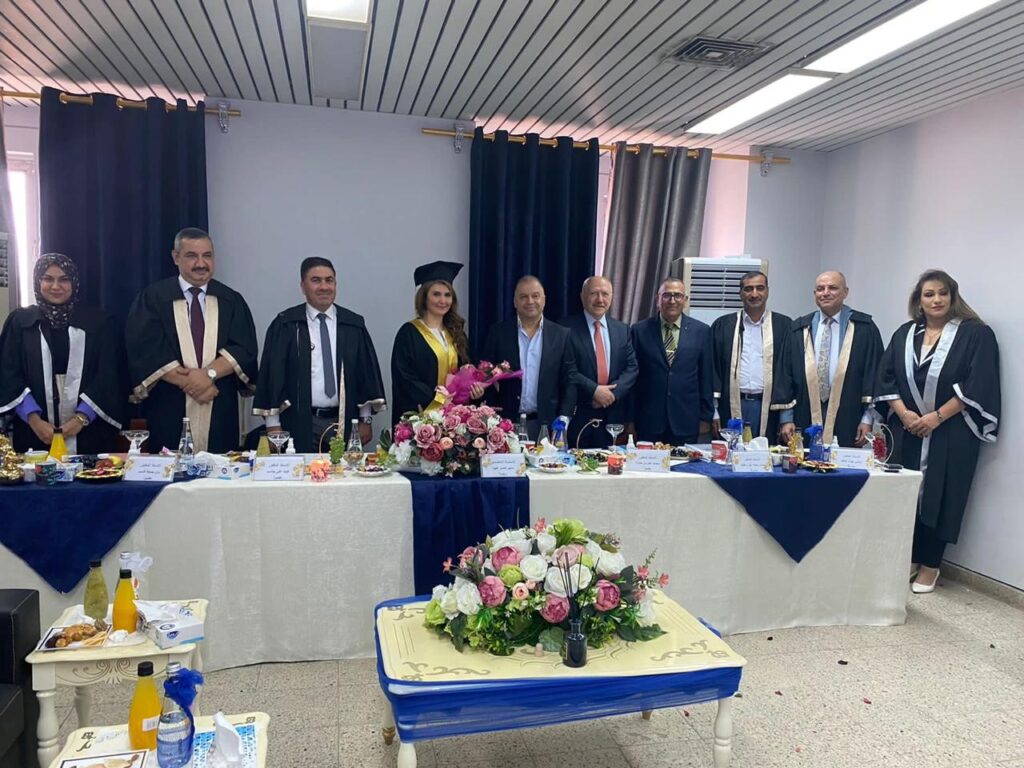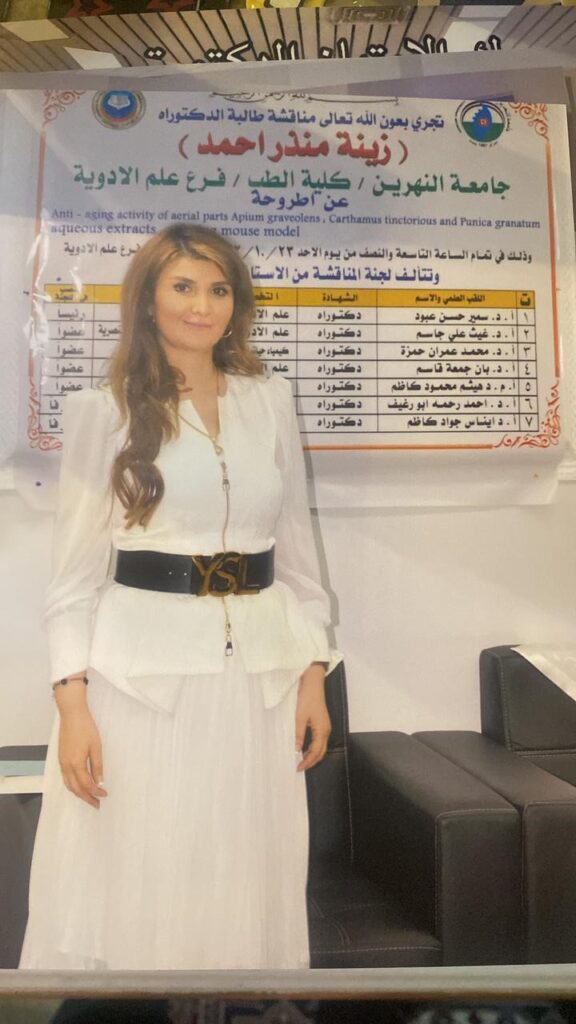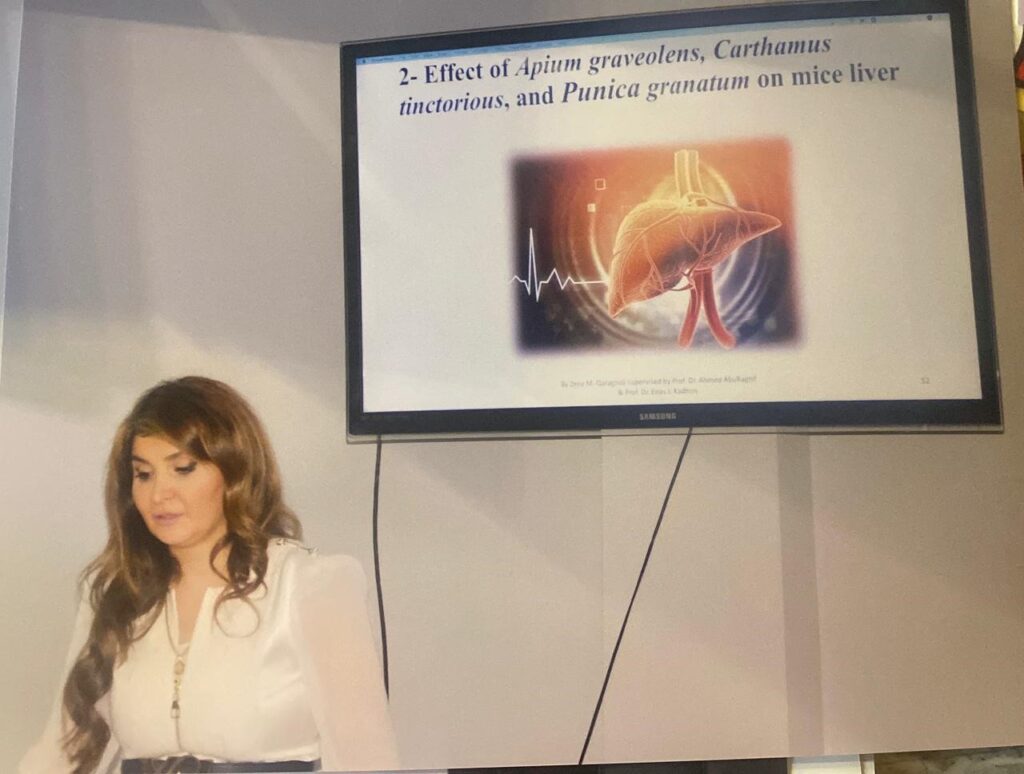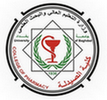The doctoral dissertation “Anti-Aging Activity of A real Parts of Apium Graveolens, Carthamus tinctorious, and Punica Granatum Aqueous Extracts on Aging Mouse Model,” written by student Zena Munther Qaragholi, an academic member in the Pharmacology and Toxicology Department, and her supervisors, Professor Dr. Ahmed Rahmah Abu-Raghif and Professor Dr. Enas Jawad Kadhim, was discussed at The Faculty of Medicine- Alnahrain University. The aim was to study the antiaging properties of the aqueous extracts of Apium graveolens (celery), Carthamus tinctorious (safflower) and Punica granatum (Pomegranate) and their combination on aging mice model on different organs of the body including skin, kidney, liver and brain. The study included seventy albino mice (male and female) that were randomly divided into 7 groups (10 mice in each group). Aged was induced in 60 mice using D-galactose, 0.3 ml at (500 mg / kg) once daily for 8 weeks. After the appearance of the signs of aging, mice were divided into the following groups, and treatment was administered orally using gastric gavage for six weeks as indicated. Group 1: (Healthy Control): Normal saline was administered intragastrically using gastric gavage once daily for 6 weeks. For the remaining 60 rats, aging was induced and then divided. Group 2: (negative control): Age-induced group, normal saline was intragastric administration using gastric gavage administered once daily for 6 weeks. Group 3: (Positive Control): Treatment with intragastric administration (100 mg / kg vitamin E) once daily for 6 weeks. Group 4: Mice were treated intragastrically using gastric gavage and the aqueous extract of safflower (Cathamus tinictorious) at a dose of 200 mg / kg for 6 weeks. Group 5: Mice were treated intragastric administration using gastric gavage with the aqueous extract of pomegranate (Punica granatum) at a dose of 800 mg / kg for 6 weeks. Group 6: Mice were treated intragastric administration using gastric gavage and the aqueous extract of celery (Apium graveolens) at a dose of 3.0 g / kg for 6 weeks. Group 7: Mice were intragastrically administered with the polyherbal extract (safflower (Cathamus tinictorious) at a dose of 200 mg / kg+ pomegranate (Punica granatum) at a dose of 800 mg / kg + celery (Apium graveolens) at a dose of 3.0 g / kg) for 6 weeks. Biochemical analysis was implemented for kidney, liver, and lipid profiles. Moreover, oxidative stress activity was measured through catalase, glutathione peroxidase, glutathione, and maloniledehyde mixed with thiobarbituric acid. Histopathology to observe tissue changes in four major organs, which are the liver, kidney, brain, and skin. A qualitative method of screening different phytochemicals, among them tannins, carbohydrates, glycosides, phenols, resins, flavonoids, saponins, alkaloids, proteins, coumarins, terpenes, and steroids, was done. The aqueous extracts were further screened using GC-MASS. Separation and identification of the three extracts was also done using HPLC, and mineral analysis of selenium, zinc and calcium were conducted using the atomic absorption spectrum. The antioxidant capacity of the three extracts was determined and compared with that of resveratrol. Biochemical analysis gave us the following results; for the kidney function tests, there was a significant difference among all the study groups at p <0.05. The highest level for all tests was in the negative control group, the aged group treated with D- Gal. while the lowest treatment group when compared to the healthy group was the combination, D-gal.+ Combination (Pomegranate 800mg+ celery 0.3mg Safflower 200mg). In the liver function tests, there was a significant difference in concentration in among all the study groups at p <0.05. For ALT, the highest concentration was found in the negative control group at 122.55±7.4 while the lowest treatment mean was found in combination group at 73.52±8.7 in comparison with the healthy group 62.00±6.45. For ASTand APL, the same significant difference was observed among the groups. While the lipid profiling was as the highest average when compared with the healthy group was the D-gal group. + Combination ( Pomegranate 800mg+ celery 0.3mg Safflower 200mg) (32.35±3.70). While for LDL the combination group gave the most significant effect when compared with the healthy control and D-gal.+ Safflower 200mg gave the second best results. The same significant difference was found for the rest of the lipid profile. Finally, for the oxidative stress parameters catalase , results illustrated that the combination group was the highest among all groups (324.97±10.04) when compared with the healthy control group (349.60±13.79). While the second best results was for D-gal.+ Safflower 200mg, (317.70±18.32). D-gal.+ Celery 0.3mg gave ( 303.09±11.30). D-gal.+ Pomegranate 800mg gave (302.02±13.31). while D-gal.+Vit.E 100mg ( positive control) gave only (292.92±15.84). For GSH-Px also showed that the combination group was the highest among all groups (110.39±5.57) and the healthy was (118.73±5.45) and the second best was D-gal.+ Safflower 200mg, then D-gal.+ Celery 0.3mg and then D-gal.+ Pomegranate 800mg. D-gal.+Vit.E 100mg ( Positive control) gave (93.20±5.09) which was almost close to the negative control (91.53±3.73). For GSH, results were in the same sequence, for the very best was the combination (Pomegranate 800mg + celery 0.3mg Safflower 200mg) (4.10±0.31) compared with the healthy control (4.42±0.65). From all the herbal treatment groups we found a significant (P<0.05). Qualitative phytochemical screening among the three plants revealed varying results. Safflower and pomegranate exhibited similar trend in all the phytochemicals and also there presence was in abundance relative to celery plant. In celery only four phytochemicals were present tannins, carbohydrates, saponins and alkaloids whereas in pomegranate and safflower resins, alkaloids, proteins, terpenes and steroids were not detected. Gas chromatography for safflower had the highest number of major compounds, while celery had the lowest. In safflower Triisobutyl (3-phenylpropoxy) silane was the highest in concentration at 16.73% followed by N-(3-Allyl-2-oxo-2, 3-dihydro-1, 3-benzothiazol-6-yl) acetamide at 13.04% as shown in. The lowest active ingredient was for Purin-2, 6-dione at 4.88%. While for celery, the highest active component was 1H-Indole at a concentration of 16.37% followed closely by 1-Diphenyl (tert-butyl) silyloxy-4-methoxybenzene at a concentration of 13.76%. The least ingredient was 4-pyridinecarboxamide at a concentration of 4.86%. In pomegranate plant, the highest active component was 6-Octadecenoic acid, methyl ester with a concentration of 20.24% followed by 9-Hexadecenoic acid, methyl ester (z)- at 12.36% and benzaldehyde at 10.90%. 1-Decanamine had the lowest concentration at 5.59%. HPLC analysis did not reveal the six standards used in this study for safflower and pomegranate plants however, in celery plant resverastrol, B- Cysteine and rutin were identified at concentrations of 4.93%, 16.09% and 5.22 % respectively. For mineral determination, zinc was found but in low concentrations. Calcium ion was also detected in high concentrations although they were significantly lower in pomegranate plant at 35.4%. The three plant extracts showed varying degrees of antioxidant activity compared with resveratrol. Each of the three herbs used for this study Apium graveolens( celery), Carthamus tinctorious ( safflower) and Punica granatum ( Pomegranate) and their combination had exhibited an antiaging property through their ability to lower enzymes causing aging. While the combination of the three herbs in a polyherbal gave an obvious effect better than vitamin E.






